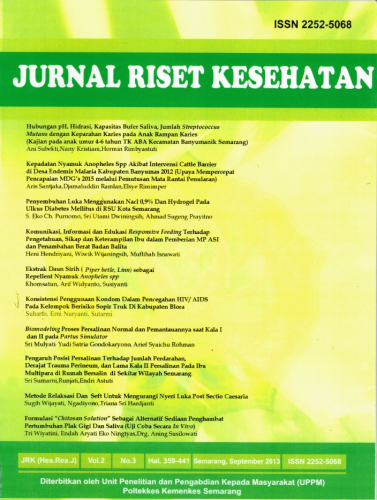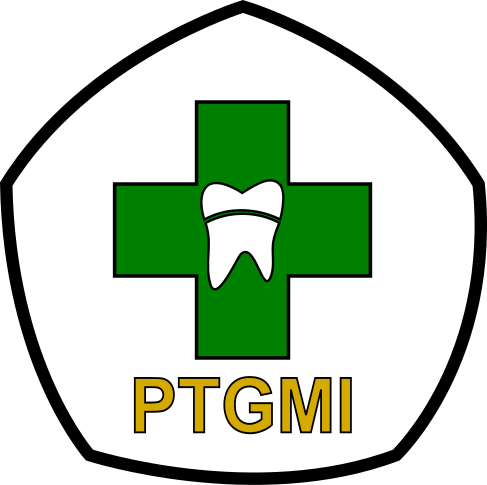INCREASE OF FOOD WASTE BASED ON FOOD TEMPERATURE AND FREQUENCY OF CHEMOTHERAPY BREAST CANCER PATIENT
Abstract
Food waste is one of the simple indicator that can be used to evaluate the success of the nutrition service of the hospital.One of the factors is frequency of chemotherapy can affect the occurrence of food waste, which aims to analyze the relationship of temperature and frequency of chemotherapy against food waste on breast cancer in patients was Dr. Kariadi Semarang. This type of research is observational research with cross sectional study approach. The research sample is 16 breast cancer patient who was elected in consecutive sampling. Statistical analysis using correlation Pearson Test to know the relationship of temperature and frequency of chemotherapy against food waste on breast cancer in patients was Dr. Kariadi Semarang. Of the total sample as much as 62.5% of the 16 people on the age group 45-64 years. The temperature of the food including the danger zone (45oC – 60oC). The food waste of staple 30.87 ± 13.58, animal side dish 42.43 ± 15,72, vegetable side dishes 35,81 ± 17,95 , vegetable 37.62 ± 18.39. The results of this research was there is a correlation between food waste and food temperature in vegetable (p = 0.038).There was a correlation between frequency of chemotherapy and food waste in staple food with (p=0.567). There was a correlation between frequency of chemotherapy and food waste in vegetable side dish with (p=0,006). There was a correlation between frequency of chemotherapy and food waste in animal side dish with (p=0,028). There was a correlation between frequency of chemotherapy and food waste in vegeteble (p=0,004). There was a correlation between the food temperature and food waste of vegetable menu. There was a relationship between frequency of chemotherapy with food waste of staple food, animal side dish, vegetable side dish and vegetable.
Keywords
Full Text:
PDFReferences
Aula LE. Faktor-faktor yang berhubungan dengan terjadinya sisa makanan pada pasien rawat inap di Rumah Sakit Haji Jakarta tahun 2011. Skripsi. Jakarta: Program Studi Kesehatan Masyarakat Fakultas Kedokteran dan Ilmu Kesehatan Universitas Islam Negeri Syarif Hidayatullah Jakarta
Corwin, E. J. (2009). Buku saku patofisiologi. Jakarta: EGC
Departemen Kesehatan Republik Indonesia. (2013). Riset kesehatan dasar 2013.
Ismi, Mirzana. 2008. Asupan Energi, Protein dan Status Gizi Pada Pasien Kanker Serviks Dengan Terapi Kemoradiasi. Universitas Diponegoro
Kusuma HS, Maghfiroh, Bintanah S. (2014). Hubungan Asupan Protein dan Kadar Albumin pada Pasien Kanker di Rumah Sakit Roemani Muhammadiyah semarang. Jurnal Gizi. Vol 3 No 2 Hal : 43-52.
Medical Record of Dr. Karyadi Hospital Semarang, 2019.
Muliani U. (2013). Faktor-faktor yang Berhubungan dengan Sisa Makanan Saring Pasien Rawat Inap. Jurnal Ilmiah Keperawatan Sai Betik. Vol 9 No 1 Hal :31-36.
Mustakim, Kusuma HS, Ulvie YNS. (2018). The Differences of Food Waste in Animal Side Dishes Based on Garnish Giving. Nutri-Sains. Vol 2 No 1 Hal : 18-23.
Nuryati P. Hubungan Antara Waktu Penyajian, Penampilan dan Rasa Makanan dengan Sisa Makanan pada Pasien Rawat Inap Dewasa di RS Bhakti Wira Tamtama Semarang. 2008. UNIMUS Digital Library Universitas Muhammadiyah Semarang. Available from: http://digilib. unimus.ac.id.
Semedi P, Kartasurya MI, Hagnyonowati. 2013. Hubungan Kepuasan Pelayanan Makanan Rumah Sakit dan Asupan Makanan dengan Perubahan Status Gizi Pasien: Studi di RSUD Sunan Kalijaga, Kabupaten Demak. Jurnal Gizi Indonesia 2 (1): 32-41
DOI: https://doi.org/10.31983/jrk.v9i1.5692
Article Metrics
Refbacks
- There are currently no refbacks.
Copyright (c) 2020 Jurnal Riset Kesehatan














































